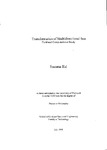Transformation of Multidirectional Sea Field and Computational Study
| dc.contributor.author | Ilic, Suzana | |
| dc.contributor.other | School of Engineering, Computing and Mathematics | en_US |
| dc.date.accessioned | 2013-09-18T11:43:52Z | |
| dc.date.available | 2013-09-18T11:43:52Z | |
| dc.date.issued | 1999 | |
| dc.identifier | NOT AVAILABLE | en_US |
| dc.identifier.uri | http://hdl.handle.net/10026.1/1848 | |
| dc.description.abstract |
A computational model based on the evolution equation for water waves (Li, 1994b) derived from the original Berkhoffs (1972) "Mild Slope Equation" is tested against multidirectional sea data. The model accounts for reflection as well as diffraction-refraction processes, which is important for applications involving coastal structures. The accuracy and convergence of the numerical solution, as well as the possibility of the implementation of an adaptive numerical scheme are investigated and implemented. The model was firstly tested using laboratory measurements (Briggs et al, 1995) of random directional wave diffraction around a semi-infinite breakwater on a flat bottom. These tests confirm the need to use "directional modelling" (using the principle of linear superposition) for the prediction of wave heights behind the breakwater. The model was then tested using directional wave data records, which were chosen from 4500 wave records collected in the field campaign, by the University of Plymouth and the University of Brighton, at Elmer - Sussex, UK from September 1993 - January 1995. The results showed that the representation of the measured random sea by monochromatic wave runs can introduce a significant error in wave height predictions shoreward of the breakwaters in the diffraction region, thus confirming the importance of directional modelling for random wave simulation. Evidence strongly suggests that non-linear wave effects have a significant influence (40-60%) on the accuracy of the model. Consequently, further tests are needed, which should also consider the influence of wave-current interaction, wave breaking, bed fiiction and transmissive boundaries. Over all the model predictions are more accurate for the controlled environment in the laboratory (5-13%), than for field conditions where the directional modelling accuracy varied from 8 - 32%. A summary of the data, collected by the author as a member of the University of Plymouth Research Team and a database of spectral and directional parameters is also presented in this thesis. Field validation of the numerical model required accurate estimates of measured data. Emphasis was placed on identifying a suitable directional analysis method, which accurately predicted direction and directional spread in the far-field from structures where reflection is still present. The non-phase-locked (hfPL) methods developed for a homogeneous sea are found to be appropriate. The anzdysis of two NPL methods, the Maximum Likelihood Method (MLM) and Bayesian Directional Method (BDM), directional estimates for simulated data shows that both methods can predict accurate incident wave height and direction. Both methods tend to overpredict directional spread and give non-accurate reflection estimates. The MLM method is easier to implement than the BDM method, which is sensitive to the chosen starting value of the hyperparameter u. As the difference between estimates of the two methods for numerical data is small, the MLM method's estimates were chosen for model testing. | |
| dc.language.iso | en | en_US |
| dc.publisher | University of Plymouth | en_US |
| dc.title | Transformation of Multidirectional Sea Field and Computational Study | en_US |
| dc.type | Thesis | |
| plymouth.version | Full version | en_US |
| dc.identifier.doi | http://dx.doi.org/10.24382/1516 | |
| dc.identifier.doi | http://dx.doi.org/10.24382/1516 |
Files in this item
This item appears in the following Collection(s)
-
01 Research Theses Main Collection
Research Theses Main


